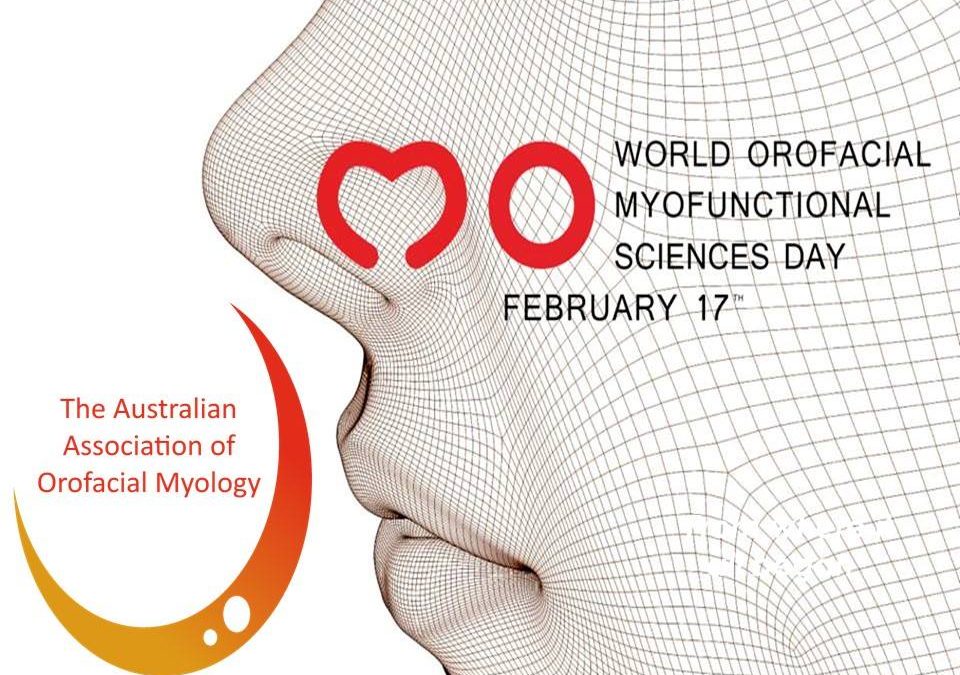
World Myofunctional Sciences Day
It’s just passed! It was Friday 17th February. How did you celebrate?

It’s just passed! It was Friday 17th February. How did you celebrate?

I was watching The Project tonight, and they had a story about snoring, or rather, how to stop snoring. It caught my attention!
The show demonstrated facial exercises that a person can do to eliminate snoring. Nothing wrong with that!
But, do you know, that’s exactly what Orofacial Myology does – trains the muscles of the lips, tongue, face and neck to promote optimal good health. This may be to help someone stop snoring, help a child fix muscular problems often associated with a lisp, stop thumb or finger sucking, promote nasal breathing, or even help to improve a person’s facial appearance, whether it be ageing or asymmetrical! It can also help in the retention of dental and/or orthodontic treatment.
Yes, it does take dedication.
Yes, it does take practice.
Anything worth doing takes effort.
But the results can be amazing. And there are less intense maintenance exercises once the initial therapy period is complete, to ensure the muscles continue to retain their optimal strength and tone.
Have a look at tonight’s (04/08/2015) episode at The Project if you didn’t see it in real time. Then, any questions, give me a call, or refer me on!
Our speech pathology and psychology clinic is located in Braddon, ACT, in Canberra’s CBD. Call us on 5117 4890 or email reception@inpositivehealth.com to get in touch.
In Positive Health, Canberra. Nel MacBean Speech Pathologist Canberra. Campbell MacBean Psychologist Canberra.

For those of you who thought it could be that all three, given the circumstances, can understand and/ or speak English (think famous Mr Ed the Talking Horse, or Skippy the Bush Kangaroo….), it’s not that.
Humans, horses and kangaroos are born breathing through their noses. That’s right. All three living creatures are nasal breathers.
But, a proportion of one of these creatures has, in recent times, begun mouth breathing. Can you guess who?
Yep, the human being.
“Why?” I hear you ask.
Studies undertaken by a fellow called George Catlin in 1870, who conducted research amongst indigenous North-Americans and wrote a detailed paper entitled “Shut Your Mouth and Save Your Life”, reasoned that “there is no animal in nature, excepting Man, that sleeps with the mouth open…which is not natural.” He goes on to say that as opposed to the native American tribes, who, at that time, were reported to be less subject to tooth decay and ill-health, “Civilised…man….is nurtured and raised amidst enervating luxuries and unnatural warmth…”
Current studies have also linked the prevalence of mouth breathing to changes in our western diet – specifically more sugar and preservatives in the diet, leading to higher levels of acidity and disharmony in the gut, causing the balance of carbon dioxide and oxygen in the blood to be out of whack, and resulting in the body’s need to over-breathe to compensate for this chemical misalignment. And when you breathe through your mouth, you can breathe in more air, in an attempt to repair this imbalance.
Ok, so you think. Isn’t that then the body’s way of adjusting to our modern times and so it’s all ok?
NO!
The problem is, thanks to Isaac Newton and his pesky little Third Law of Motion: For every action there is an equal and opposite reaction.
In other words, there are consequences….
Irrespective of the why, what are the effects of mouth breathing? For simplicity, clarity and brevity, I’ll write a list, which is by no means exhaustive:
So, do you breathe through your nose or your mouth? What about your children? Observe them sleeping. Are they nasal breathers or mouth breathers? Can you tick off any of the symptoms above?
And if you can, what should you do about it? Well, you can start breathing through your nose, for a start, but for some people that might be really hard. They might need some help.
That is where I come in, as a Speech Pathologist and, particularly, as an Orofacial Myologist.
Watch this space for further information – coming soon!
In Positive Health, Canberra. Nel MacBean Speech Pathologist Canberra. Campbell MacBean Psychologist Canberra.

‘Oro’ refers to the oral cavity, or the mouth… ‘facial’ refers to the face….and ‘myo’ is a prefix which stands for ‘muscle’. In other words, Orofacial Myology is all about assessing and providing exercises for the lips, tongue, jaw and facial muscles to improve symmetry, function and form.
People who would benefit from OM treatment include those who:
o breathe predominantly through their mouth, rather than their nose;
o have ever sucked their thumb and/or finger(s);
o have been diagnosed with Sleep Apnoea or do not sleep well; and,
o chew with their mouth open and/ or swallow incorrectly.
For more information and FAQs on Orofacial Myology, consult the International Association of Orofacial Myology
Our speech pathology and psychology clinic is located in Braddon, ACT, in Canberra’s CBD. Call us on 5117 4890 or email reception@inpositivehealth.com to get in touch.
In Positive Health, Canberra. Nel MacBean Speech Pathologist Canberra. Campbell MacBean Psychologist Canberra.

Did you know Speech Pathology Australia has a number of Fact Sheets to provide members of the public with information about communication and swallowing disorders?
They can be accessed here on the SPA website.
Of course, if you’d like any further information, just ask us – we are only too happy to talk, clarify, provide information in more detail or just listen. It’s nice to have a sounding board sometimes.
In Positive Health, Canberra. Nel MacBean Speech Pathologist Canberra. Campbell MacBean Psychologist Canberra.